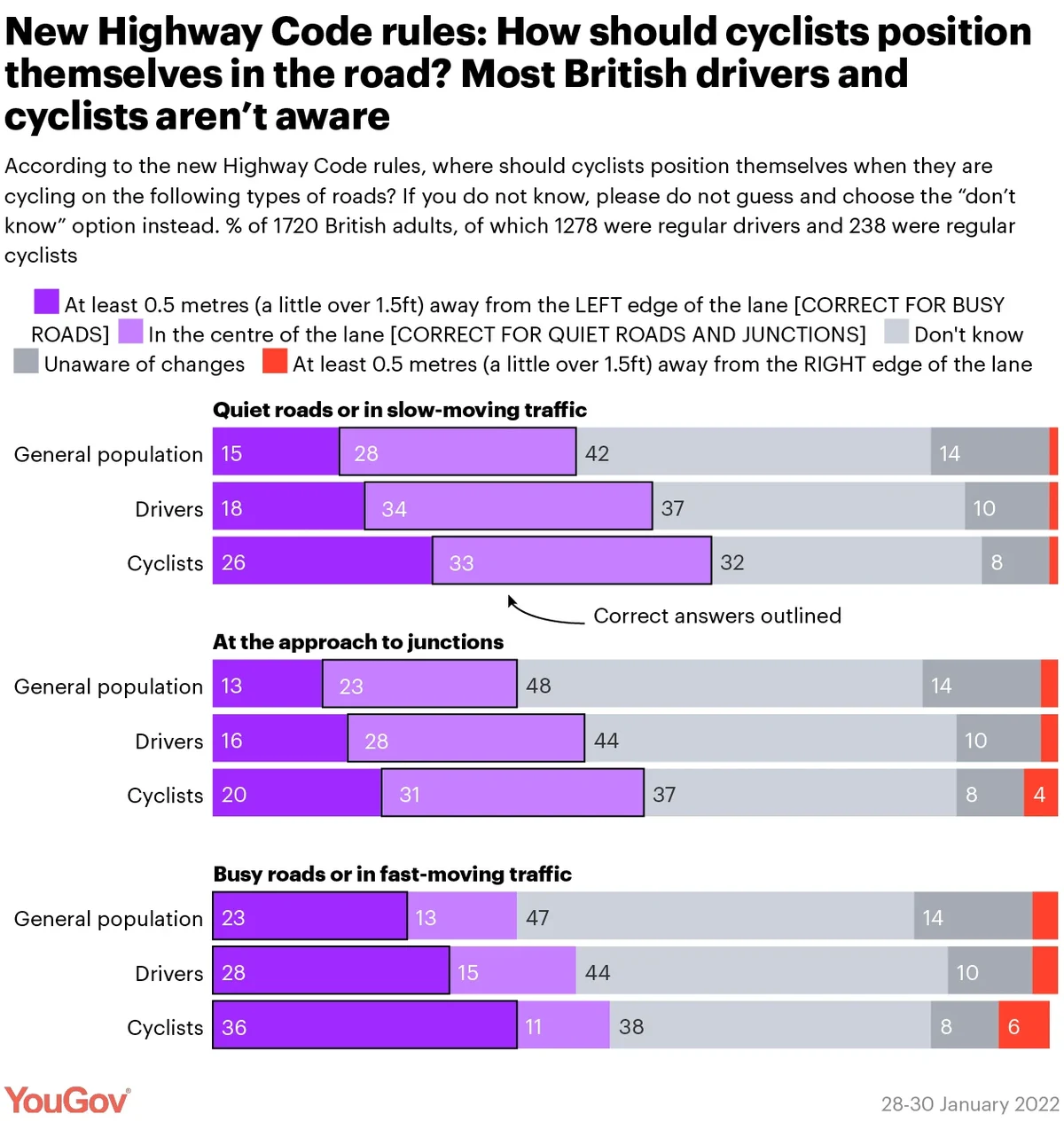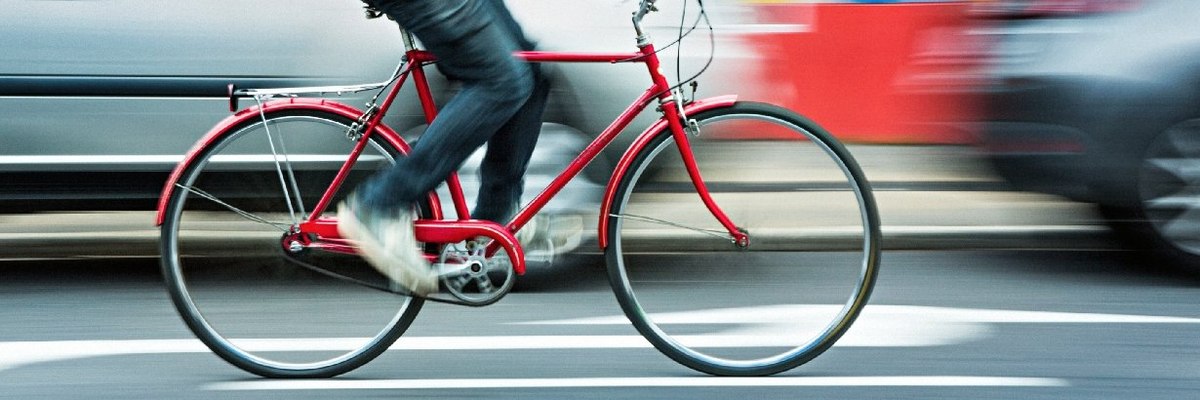Understanding of the new guidance in the Highway Code is extremely varied, and 14% of Britons have no idea that the code is changing at all
The Highway Code, which is a set of rules and guidelines for road users in the UK, underwent a series of changes which came into force on Saturday 29 January. The changes, which are broadly geared towards making the road safer for cyclists and other non-vehicle users, amount to nine updated sections and 50 added or amended rules and have already caused a backlash among motorist pressure groups.
A new YouGov survey, carried out on the weekend that the rules changed (fieldwork 28-30 January), reveals that many Britons had not heard about the Highway Code changing – and even for those who say they had, understanding of the new rules is patchy at best.
Are Britons aware that the Highway Code has changed?
Around half of Britons say they have heard a great deal (8%) or a fair amount (40%) about the changes taking place in the Highway Code. A further third (35%) say they have not heard much, while 14% say they have not heard anything about changes to the Highway Code.
Awareness around the code changing was higher in cyclists and drivers compared to the wider British public. More than half of regular drivers (55%) and regular cyclists (56%) say they have heard ‘a great deal’ or ‘a fair amount’ about the changes to the code. That’s compared to 10% of drivers and 8% of cyclists who say they have heard nothing at all about changes to the rules of the road.
When it comes to knowledge of the ways in which the rules have actually changed, a lower proportion of Britons (40%) say they are ‘very’ or ‘fairly’ familiar, with around the same proportion (42%) saying they are ‘not very’ or ‘not at all’ familiar. Again, perceived familiarity with the ways in which the code is changing is higher among drivers (48%) and cyclists (50%).
However, the vast majority of Britons are either completely unaware on what date the new rules and guidelines come into force or are incorrect about which date. A total of 87% of Britons don’t know what date the rules changed, with just 13% saying the correct date (Saturday 29 January).
Do Britons know what the new Highway Code rules are?
While a good proportion of Britons say they are familiar with the changes taking place in the Highway Code, our survey reveals that public knowledge of the specific new rules and guidelines varies significantly, although regular cyclists and drivers tend to have a greater understanding of the changes.
Who has the right of way is someone is driving a car and turning into a road and there is a pedestrian waiting to cross?
Arguably the most well-publicised new rule – that of giving pedestrians waiting to cross a road right of way – is correctly identified by two-thirds (67%) of Britons, rising to three-quarters of drivers (75%).
Similarly, if a driver is turning into a junction and a cyclist, horse rider or horse-drawn vehicle is going straight ahead, more than half (57%) of Britons are able to correctly answer that the cyclist, horse-rider or horse-drawn vehicle has priority over the driver. Understanding is higher among cyclists (66%) and drivers (65%), as before.
However, these are the only two rules which the majority of the British public are able to identify correctly.
How should someone in a car open their car door?
The ‘Dutch reach’ is a new recommended way for people in cars to open their car doors, which involves reaching over the body with the hand furthest away from the door. It’s meant to be safer, as it forces a person in a car to turn around and look at the road, making it much less likely that they will hit a cyclist with their opening door. Around two in five (43%) Britons identify the Dutch reach as the correct way of opening car doors according to the new Highway Code.
Who has right of way on shared-use cycle tracks: cyclists or pedestrians?
The Highway Code’s new ‘hierarchy of road users’ states that the user who would cause the greatest harm in the event of a collision bears the greatest responsibility to take care on the road. Practically, this translates into several amended rules about right of way when it comes to different types of road users – pedestrians having right of way in shared-use cycle tracks, for example. But just a third (33%) of Britons are able to correctly choose who has right of way in this particular situation.
On which side should a cyclist pass a horse?
Britons have similarly low understanding of other new rules specifically involving cyclists, and although knowledge was higher among cyclists, it is still by no means high. Three in 10 (29%) Britons are able to correctly say that according to the new rules, a cyclist should pass a horse on the horse’s right hand side (i.e. not undertaking), rising to 34% of drivers and 43% of cyclists.
Can cyclists ride abreast of each other, or do they have to ride single file?
A similar proportion (28%) of the public, 37% of cyclists and 33% of drivers can correctly answer that according to the new rules, groups of cyclists should ride no more than two abreast in the road. This was explicit guidance in the prior Highway Code, but is still inferred in the updated rules.
Where should cyclists position themselves on different roads?
Understanding of the new rules about where cyclists should position themselves is 28% for quiet roads and slow moving traffic (in the centre of the lane), 23% for busy roads or in fast-moving traffic (at least half a metre from the left of the lane) and 23% for the approach to junctions (in the centre of the lane). For cyclists, these figures were 33%, 36% and 31% respectively, and for drivers, 34%, 28% and 38%.

How much room should a driver give when passing a cyclist?
There was also low comprehension of the new guidelines involving how much space a driver should leave when overtaking cyclists at speeds of up to 30mph. Just a quarter (25%) of Britons know that overtaking drivers should leave 1.5m of space (a little under 5ft).
What should cyclists do when a car wants to overtake?
Just 10% of Britons know that the updated Highway Code states that in a situation where a group of cyclists are riding abreast and a motorist wishes to overtake, the cyclists should wait until it is safe for the motorist to pass and then move over or stop, rather than having to immediately make way or continuing to take the same space on the road.
Do drivers have to stop for people waiting at zebra crossings?
Britons were most ‘confidently incorrect’ about the new rule involving giving way to pedestrians at a zebra crossing. Just 21% of the British public know that according to the new rules, you must give way to pedestrians already on the crossing (which was already a part of the old guidance) and you should give way to pedestrians waiting to cross (which is the updated guidance). Four in 10 (40%) incorrectly say that you must give way to pedestrians both on the crossing and waiting to cross.
See full results here










